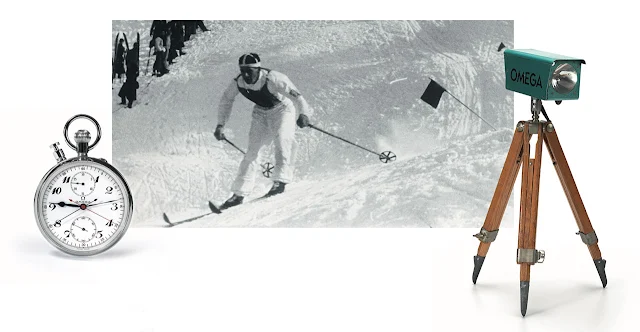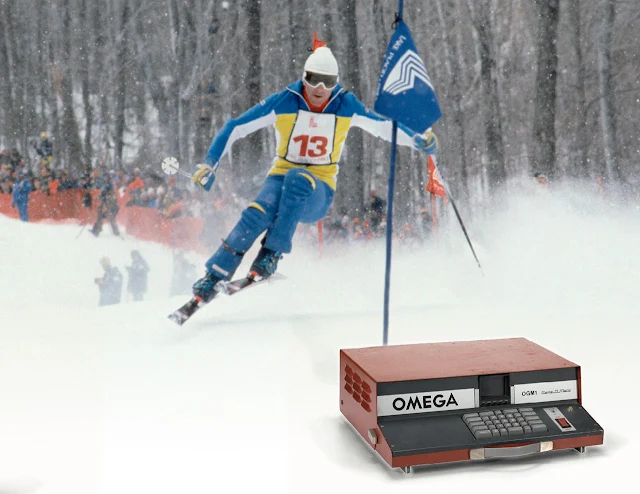History of Omega's timekeeping technologies for the Olympic Winter Games and the innovations introduced at Beijing 2022
Beijing 2022 will mark a special milestone for Omega as the Swiss brand celebrates its 30th occasion as Official Timekeeper of the Olympic Games. For exactly 90 years, Omega has been a leading name in sports measurement, continually developing the technologies that every result depends on.
When Omega began its role in 1932, the company fulfilled its task with just one watchmaker and 30 stopwatches. This year in Beijing, the operation will entail a team of 300 timekeepers and 200 tonnes of equipment, a demonstration of the growing importance of this role.
Over the years, Omega introduced many important innovations that dramatically changed the way we live these exciting sport events. Below, we list just a few of them.
1936 was the first year that Omega officially timed the Olympic Winter Games. With a single watchmaker and 27 stop-watches, the brand fulfilled is role measuring every moment at Garmisch-Partenkirchen.
1948 marked the beginning of the electronic era when Omega’s photoelectric cells were used for the first time at the Olympic Games to automatically stop the clock on the finish line of races, thus replacing the human eye.
At the VII Edition of the Winter Games held in Cortina d'Ampezzo (1956), Omega introduced starting gates in alpine skiing at the Olympic Games. The Omega Quartz Recorder was triggered as soon as the athletes passed through, signalling the beginning of each run.
In 1964 the times of Olympic Games performances were superimposed onto the bottom of television screens for the first time thanks to a new piece of technology known as the Omegascope. In 1968, the technology was further developed making it possible to superimpose complete competition details including athlete names, live times, final times, intermediate times and speeds.
The 1980 Game-O-Matic technology could immediately calculate and display an athlete’s ranking as soon as he or she crossed the finish line in alpine skiing events held in Lake Placid.
Introduced in 1992 in Albertville, the new Scan’O’Vision system could digitally measure times to the nearest 1/1000th of a second, opening a new chapter in the science of timekeeping.
The new, futuristic Electronic Start Pistol (Vancouver, 2010) was followed in 2014 at Sochi by a new Whistle Detection System in Ice Hockey. This was worn by officials, and the microphone allowed them to speak to the scorekeeper on the timing bench. The system also stopped the clock as soon as it detected the sound of a referee’s whistle. This would happen at least half a second faster than any timekeeper could manually achieve.
The continuous stream of innovation continues at Beijing 2022, when Omega will be introducing three new technologies that we describe below.
Figure Skating – Jump Analysis
As a continuation of Omega’s motion sensor and positioning systems, the sport of figure skating will now be analysed in much greater depth. Six cameras will be placed around the ice, and during single skater events, they will be able to capture a range of live data, including the height of a jump, the length of the jump, and the amount of time a skater spends in the air. By tracking positions and motions, the new system will be a fascinating way to understand the skater’s execution of their routine, and to see how each competitor compares against another.
Speed Skating – False Start Detection
False starts will be revolutionised in Beijing. Until now, the sport relied on the judge’s eye to detect any movement of the athlete or their blades before the start of a race. Now, Omega will utilise its image tracking system to visually detect a false start, providing much more reliability in this crucial moment. With one camera positioned in each lane, the system will be visually monitored by officials, who will provide the judge with an immediate indication should a false start be observed.
Ice Hockey – In-Game Display
A new in-game display for the sport of Ice Hockey will feature LEDs integrated within the plexi-glass around the rink. The one-sided transparent clock will be able to indicate game time and penalty time shown in the middle of the rink between the two penalty boxes. This display will be of a great added value to players now receiving those crucial information all along during the game.
To celebrate this sport event, Omega also launched two special timepieces: the Seamaster Diver 300M Beijing 2022 Special Edition and the Aqua Terra 150M Beijing 2022.
To discover them, just follow the related links. omegawatches.com
























COMMENTS